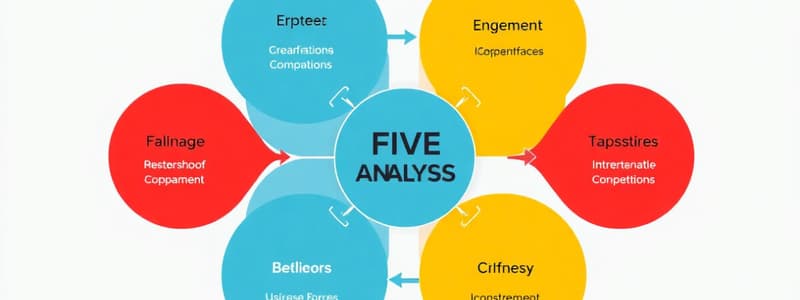Podcast
Questions and Answers
When considering the power of an industry's buyer, in what situation does a buyer's power become amplified?
When considering the power of an industry's buyer, in what situation does a buyer's power become amplified?
- When the seller relies on a single buyer for a significant portion of their sales. (correct)
- When the buyer has numerous substitutes available.
- When the buyer's switching costs are high.
- When the seller's switching costs are high.
- When the seller offers a unique product or service.
Which of these factors is NOT directly associated with intense rivalry among competitors in an industry?
Which of these factors is NOT directly associated with intense rivalry among competitors in an industry?
- High product differentiation. (correct)
- Low switching costs for buyers.
- Differing strategies among competitors in different geographic markets.
- A substantial number of competitors.
- A significant increase in the quality of substitute products.
What is a key limitation of Porter's Five Forces Analysis in understanding competitive dynamics?
What is a key limitation of Porter's Five Forces Analysis in understanding competitive dynamics?
- It fails to adequately consider the impact of cultural factors on consumer behavior.
- It overemphasizes the role of technology in shaping industry competition.
- It ignores the impact of external factors like government regulations.
- It does not account for the potential for collaboration and mutual gain among industry players. (correct)
Which of the following scenarios is a direct indicator of strong bargaining power of suppliers in an industry?
Which of the following scenarios is a direct indicator of strong bargaining power of suppliers in an industry?
What is the primary purpose of 'internal firm analysis' within the context of competitive advantage?
What is the primary purpose of 'internal firm analysis' within the context of competitive advantage?
Which factor is NOT a significant influence on the decline of consumer demand for a product?
Which factor is NOT a significant influence on the decline of consumer demand for a product?
Under which of these conditions would rivalry be considered weak in an industry?
Under which of these conditions would rivalry be considered weak in an industry?
Which of the following scenarios is LEAST likely to indicate a strong rivalry among competitors in an industry?
Which of the following scenarios is LEAST likely to indicate a strong rivalry among competitors in an industry?
Which type of intellectual property helps protect inventions from imitation?
Which type of intellectual property helps protect inventions from imitation?
In SWOT analysis, which factor would be classified as a threat?
In SWOT analysis, which factor would be classified as a threat?
Which component of the value chain analysis involves converting inputs into products?
Which component of the value chain analysis involves converting inputs into products?
What is the primary function of support activities in the value chain?
What is the primary function of support activities in the value chain?
Which of the following best defines the term 'Dogs' in the context of market share and growth?
Which of the following best defines the term 'Dogs' in the context of market share and growth?
What factor does NOT indicate strong buyer bargaining power?
What factor does NOT indicate strong buyer bargaining power?
Which statement best describes the Resource-Based View (RBV)?
Which statement best describes the Resource-Based View (RBV)?
In the context of the VRIO Framework, what does 'Imitability' refer to?
In the context of the VRIO Framework, what does 'Imitability' refer to?
Which of the following describes a company categorized as a 'Cash Cow' in the BCG Growth-Share Matrix?
Which of the following describes a company categorized as a 'Cash Cow' in the BCG Growth-Share Matrix?
What does a mixture of strong and weak forces in industry competition indicate?
What does a mixture of strong and weak forces in industry competition indicate?
Which of the following would likely NOT constitute a characteristic of a high bargaining power buyer?
Which of the following would likely NOT constitute a characteristic of a high bargaining power buyer?
What is a primary outcome of strong competitive forces in an industry?
What is a primary outcome of strong competitive forces in an industry?
In assessing a resource's value in the VRIO framework, which aspect is evaluated?
In assessing a resource's value in the VRIO framework, which aspect is evaluated?
What is the main premise of an industry's rivalry?
What is the main premise of an industry's rivalry?
Which of these indicators signifies a robust rivalry amongst competitors?
Which of these indicators signifies a robust rivalry amongst competitors?
In a highly competitive industry, which factor would likely contribute to the most intense rivalry?
In a highly competitive industry, which factor would likely contribute to the most intense rivalry?
Which of these is NOT a factor directly impacting the threat of potential new entrants into an industry?
Which of these is NOT a factor directly impacting the threat of potential new entrants into an industry?
What makes it difficult for new entrants to compete with established firms in an industry?
What makes it difficult for new entrants to compete with established firms in an industry?
Which of these factors would likely make a product or service a strong substitute for the existing offerings in an industry?
Which of these factors would likely make a product or service a strong substitute for the existing offerings in an industry?
Which condition would likely reduce the threat of substitutes in an industry?
Which condition would likely reduce the threat of substitutes in an industry?
Which characteristic would make it more challenging for companies to differentiate their products successfully in a highly competitive industry?
Which characteristic would make it more challenging for companies to differentiate their products successfully in a highly competitive industry?
Flashcards
SWOT Analysis
SWOT Analysis
A strategic tool to evaluate strengths, weaknesses, opportunities, and threats.
Value Chain Analysis
Value Chain Analysis
A framework for analyzing how a firm gains a competitive advantage through business activities.
Primary Activities
Primary Activities
Direct actions that create value, including logistics, operations, sales, and service.
Intellectual Property Types
Intellectual Property Types
Signup and view all the flashcards
Dogs (BCG Matrix)
Dogs (BCG Matrix)
Signup and view all the flashcards
Bargaining Power of Buyers
Bargaining Power of Buyers
Signup and view all the flashcards
Backwards Integration
Backwards Integration
Signup and view all the flashcards
Cost of Switching Suppliers
Cost of Switching Suppliers
Signup and view all the flashcards
Resource-Based View (RBV)
Resource-Based View (RBV)
Signup and view all the flashcards
Tangible Resources
Tangible Resources
Signup and view all the flashcards
VRIO Framework
VRIO Framework
Signup and view all the flashcards
BCG Growth-Share Matrix
BCG Growth-Share Matrix
Signup and view all the flashcards
Competitive Advantage
Competitive Advantage
Signup and view all the flashcards
Five Forces Analysis
Five Forces Analysis
Signup and view all the flashcards
Rivalry among Competitors
Rivalry among Competitors
Signup and view all the flashcards
Threat of New Entrants
Threat of New Entrants
Signup and view all the flashcards
Barriers to Entry
Barriers to Entry
Signup and view all the flashcards
Substitutes
Substitutes
Signup and view all the flashcards
Competitor Actions
Competitor Actions
Signup and view all the flashcards
High Switching Costs
High Switching Costs
Signup and view all the flashcards
Market Demand Growth
Market Demand Growth
Signup and view all the flashcards
Falling consumer demand
Falling consumer demand
Signup and view all the flashcards
Substitute products
Substitute products
Signup and view all the flashcards
Switching costs
Switching costs
Signup and view all the flashcards
Product differentiation
Product differentiation
Signup and view all the flashcards
Bargaining power of suppliers
Bargaining power of suppliers
Signup and view all the flashcards
Collaboration in competition
Collaboration in competition
Signup and view all the flashcards
Internal firm analysis
Internal firm analysis
Signup and view all the flashcards
Study Notes
Five Forces Analysis
- Considers interactions among competitors, new entrants, substitutes, suppliers, and buyers.
Rivalry Among Competitors
- Competitors (firms producing similar products/services) use tactics like advertising, new offerings, and price cuts to gain market share.
- Rivalry intensity is determined by factors like the number of competitors, industry growth rate, product/service characteristics, fixed costs, increasing capacity, and diversity of rivals.
- Strong rivalry occurs when consumer demand falls, excess capacity exists, buyers have low switching costs, rivals have diverse market strategies, and competitors constantly improve performance/increase numbers.
- Weak rivalry occurs when product differentiation is high, competitors are non-aggressive, high buyer switching costs, strong consumer demand, few but more than 5 competitors.
Threat of Potential New Entrants
- New competitors entering an industry (new entrants) bring new products, services, and capacity, potentially reducing profits for existing firms.
- Threats are high if barriers to entry are low (e.g., weak government regulations, low capital requirements, easy access to distribution channels, low switching costs).
- High initial investment, strict regulations, high differentiation costs/switching costs, limited access to distribution channels make the threat of new competitors less of a threat.
Threat of Substitutes
- Substitute products can significantly threaten an industry if they are substantially cheaper, customer preferences change, substitute quality drastically improves, switching cost is low, and differentiation is low.
Power of Suppliers
- Strong supplier power exists when the product/service is unique, switching costs are high, few suppliers exist, high sales volume, no readily available substitutes.
- Low supplier power is when many suppliers exist, switching costs are low, there are many substitutes available on the market.
Power of Buyers
- Buyer power is strong when buyers can potentially integrate backward (produce their own products), switching costs to another supplier are low, large portion of a seller's product is purchased by the buyer, several suppliers are available in the market, and the product represents a high percentage of the buyer's cost.
Interpreting the Five Forces
- Porter's Five Forces ranks competitive forces as Strong/High, Moderate/Medium, or Weak/Low based on competition level and profit potential.
- Weak forces indicate desirable markets, high desirability, higher profitability; strong forces indicate higher competition and low profit.
- Firms use this analysis to enter or exit markets, develop competitive strategies.
Internal Firm Analysis and Competitive Advantage
- Internal assessments help firms understand their position compared to competitors.
- Evaluating resources and capabilities is crucial for developing a competitive edge.
- Advantage can be temporary or sustained.
Resource-Based View (RBV) and VRIO Framework
- RBV assesses tangible (physical assets) and intangible (knowledge, brand) resources for strategic advantage.
- VRIO framework analyzes resources/capabilities – Value, Rareness, Imitability, and Organization.
BCG Growth-Share Matrix
- Portfolio analysis tool categorizes business units/products based on market growth rate and market share.
- Categories include Stars, Cash Cows, Question Marks, and Dogs.
SWOT Analysis
- Structured framework for assessing internal (strengths, weaknesses) and external (opportunities, threats) factors.
- Used to identify business opportunities, market, and internal competitive advantages.
Intellectual Property and Competitive Edge
- Protecting unique creations (patents, trademarks, copyrights, trade secrets) gives competitive advantage.
Value Chain Analysis
- Developed by Michael Porter, examines how a firm adds value through activities (primary and support).
- Primary activities directly add value, while support activities enhance primary activity effectiveness (procurement, technology, HR, infrastructure).
Studying That Suits You
Use AI to generate personalized quizzes and flashcards to suit your learning preferences.




